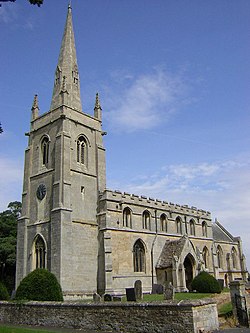Aswarby
- Not to be confused with Aswardby
| Aswarby | |
| Lincolnshire | |
|---|---|
 St Denys' Church, Aswarby | |
| Location | |
| Grid reference: | TF066397 |
| Location: | 52°56’42"N, 0°24’49"W |
| Data | |
| Post town: | Sleaford |
| Postcode: | NG34 |
| Dialling code: | 01529 |
| Local Government | |
| Council: | North Kesteven |
| Parliamentary constituency: |
Sleaford and North Hykeham |
Aswarby is a village in Kesteven, the north-western part of Lincolnshire. It is within the Aswardhurn Wapentake of Kesteven.
The village stands three and a half miles south of Sleaford and just 750 yards east of the A15 road, between Sleaford and the junction with the A52 near Threekingham.
History
The village may take its name from the old Danish name Aswarð,[1] as may the Wapentake, Aswardhurn.
There is little evidence of early occupation, but a flint axe[2] and a 2nd-century AD Roman brooch[3] were found near Aswarby.
The village is recorded in the Domesday Book as "Aswardebi". In the mid-19th century, it was moved to a new site to make way for improvements to Aswarby Park; the original position is about 500 yards to the south-west of the modern village.[4]
George Bass,[5] explorer of Australia and Tasmania, was born in Aswarby. The Bass Strait between Australia and Tasmania is named after him.
Parish church
The parish church, St Denys, is a mediæval building. Parts of the church date back to the 12th, 14th and 15th centuries. The font is 12th century with a 20th-century lid, and the chancel, designed by H. E. Kendall, was built in 1849. In 1850 the church was restored by Edward Blore. There are memorials to George Bass and members of the Whichcote family.
The church is a Grade I listed building.[6]
About the village
Aswarby Hall was the seat of the Hervey and Carr[7] (or Carre) families. Sir Francis Whichcote, 3rd Baronet moved there in the early 1700s. By the mid-19th century, it had descended to Sir Thomas Whichcote, 7th Baron Whichcote and High Sheriff of Lincolnshire.[8] It is the setting for "Lost Hearts", a ghost story by M. R. James, a writer of supernatural short fiction.[9] The hall itself was demolished in 1951, leaving only two pillars standing.[10] The surrounding park remains and is owned by Aswarby Estates.
The surviving estate properties are included in Aswarby's inventory of 19 Grade II listed buildings, which includes the Estate Office, several farmhouses, cottages, The Old Smithy, a walled garden and bothy, and a milestone.
Thirteen of the village's listed buildings are in a conservation area, as defined by Heritage Lincolnshire.
Outside links
| ("Wikimedia Commons" has material about Aswarby) |
- Aswarby in the Domesday Book
References
- ↑ "Lincs to the Past - Settlement of Aswarby". http://www.lincstothepast.com/Settlement-of-Aswarby/906174.record?pt=S. Retrieved 3 February 2013.
- ↑ "Lincs To The Past - Flint axe". http://www.lincstothepast.com/Flint-axe-found-to-the-north-west-of-North-Lodge--Aswarby/906167.record?pt=S. Retrieved 3 February 2013.
- ↑ "www.finds.org Aswarby brooch". http://www.finds.org.uk/database/artefacts/record/id/195528. Retrieved 3 February 2013.
- ↑ "Lincs To The Past - Original settlement of Aswarby". http://www.lincstothepast.com/Earthwork-remains-of-the-original-settlement-of-Aswarby/245294.record?pt=S. Retrieved 3 February 2013.
- ↑ Bishop's transcripts for Aswardby, 1561-1830, Church of England. Parish Church of Aswardby (Lincolnshire)
- ↑ National Heritage List 1360619: Church of St Denys (Grade I listing)
- ↑ "History of Parliament online - Sir Robert Carr". http://www.historyofparliamentonline.org/volume/1660-1690/member/carr-sir-robert-1637-82. Retrieved 3 February 2013.
- ↑ Information on Aswarby from GENUKI
- ↑ Google Books - Ghost Stories of An Antiquarian. https://books.google.com/books?id=lem8jHX6CdwC&q=aswarby#v=snippet&q=aswarby&f=false. Retrieved 1 February 2013.
- ↑ "Aswarby Park Pillars". http://www.lincstothepast.com/A-pair-of-pillars-in-Aswarby-Park/906146.record?pt=S. Retrieved 2 February 2013.